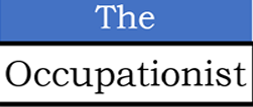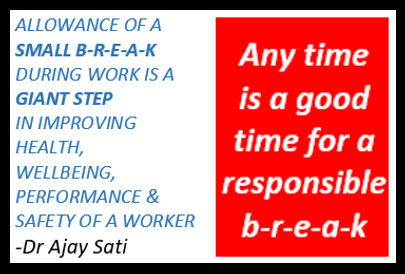Actually, most of know taking breaks during working hours is good, without knowing why. Yet, we don’t take breaks – again we don’t know why. Taking breaks is important and equally important is to know why, where, when and how to take those breaks. The onus of encouraging employees to take breaks depends on the awareness and the approach of an organization’s management and the role its managers play.
Anytime is a good time for a responsible break!
Awareness about significance of taking breaks is created by either HR or by a doctor (especially an Occupational Health physician) if the organization employs one. I remember once when I was working with an MNC, the participants were allowed to stand and listen to a speaker if sitting for a long time caused them discomfort. This was after an understanding with the CEO that it will improve attention on the employees. The presentation time of the speakers was reduced, and more bio-breaks were introduced – it is as easy as that.
Employees were happy with this initiative – the freedom to change postures when in discomfort. It was like taking a break, voiced many.
Taking breaks is important and equally important is to know why, where, when and how to take those breaks.
Taking frequent breaks throughout the day, including during non-work hours improves health, wellbeing, performance, and even safety.
Being productive is not about working for long hours, continuously. Many workers believe that spending more time on a job is equal to getting more done. In the long run that may not always be true. Workers skip lunch, stay after work hours and even avoid taking breaks for various reasons.
The onus of encouraging employees to take breaks depends on the awareness and the approach of an organization’s management and the role its managers play.
Eventually such workers’ pay a price as a recent survey from Aflac showed 59% of employees reporting feeling burnout. Add to this, employee engagement is declining among US workers (and must be declining elsewhere as well). Both, increasing burnout and reduced employee engagement are associated with hindered performance.
To address the issue of increasing burnout and declining employee engagement, the Harvard Business Review (HBR) team conducted a review of existing research on workplace breaks and analysed 80 studies. The team confirmed that stopping work for a short while throughout the day can improve wellbeing as well as help getting more work done. The research suggested that taking breaks within work hours does not reduce performance, in fact, it helps improve it.
Factoring reasonable work breaks can make the individual and/or the team more productive than trying to skip lunches and staying late at workplace. It disturbs work-life balance which in turn further reduces performance.
Taking work breaks is a very basic idea and small business owners should be aware of this if they want to improve their business performance and competitiveness. Encouraging their employees to take responsible breaks is better than not allowing them to take a break within work hours, as is the norm in small businesses.
Allowance of a even small break during work is a giant step in improving health, wellbeing, performance and safety of a worker.
However, the research pointed that not all work breaks are equally effective in improving wellbeing and performance. To make taking breaks effective, the following considerations are useful:
- Length of the break: Small frequent breaks (micro-breaks) for a few minutes help in improving performance and preventing fatigue. Breaks generally include getting off the chair, eating something, stretching or seeing a distant object from a window.
- Timing of the break: In the mornings, shorter breaks are useful. Longer breaks are effective in the second half of the work day (afternoon) as fatigue sets in and takes longer time to stabilise.
- Where should the break be taken: One can take a break sitting at the desk but research indicated that outdoor breaks were most effective especially in a green lawn.
- Activities to be done during a break: One should do some physical activity during the break – walk, stretch etc. to yield benefits of break time. If during a break you spend time on social media (and 97% of people do that), it leads to emotional exhaustion which reduces creativity as well as performance.
- Role of pets: Interactions with pets (a dog) helps but it may not be practicable in offices. However, I have advocated having a few small fish tanks in offices as they too have substantial benefits, are affordable and do not occupy much space.
What organizations can do to encourage breaks during work time:
- Walk the talk: The CEO and the senior management should ‘walk the talk,’ they should be seen taking breaks. In fact, the organization should have ‘taking breaks’ as one of the priorities to improve creativity and performance. In townhalls (employee gatherings), the CEO must emphasize on benefits of taking breaks, only then employees perceive it as a sanctioned benefit.
- Have dedicated time for breaks: It may not be possible in a big office employing thousands of employees, but teams could meet at a scheduled time for a short break once or twice a week, as in addition to fostering positive attitude towards breaks, it also help bond the teams. On other days, to each one his/her own, one could take multiple breaks anytime.
- List places for breaks: The employees could go to a nearby green space (garden), or to a mall, or to a tea-stall (called tapri in India) depending on the location and size of its office. A large office complex that runs into acres may have everything inhouse and employees should be encouraged to make use of it.
Taking breaks during work time may be abused, hence the term ‘taking responsible breaks’ is apt and should be emphasized. Monitoring or doubting the employees ‘break time’ will not help – in fact, it will only increase the stigma and guilt that is prevalent around taking breaks, a reason why employees don’t take breaks.
Individuals working in small businesses should talk to business owners and get a sanction to take responsible breaks, citing the Harvard Business Review study.
While organizations are redefining the issue of employee wellbeing, work break appears to be a promising tool to improve both – employee wellbeing as well as performance. The Occupational Health physician or the wellness manager, as the case may be, should make the senior management understand the value of research on work breaks so that they can encourage to design the process.
While the focus of this blog was on how work breaks can improve wellbeing and performance, it can be easily understood that taking frequent breaks also helps reduce the aches and pains due to repetitive tasks such as typing while working on computers etc. thus preventing health from deteriorating.
Breaks during work time are not only good for health, wellbeing and performance but also good for safety as they reduce fatigue and may prevent many accidents (industrial as well as non-industrial) that happen due to continuous working.
Individuals working in small businesses should talk to business owners and get a sanction to take responsible breaks, citing the HBR study as above. With time the business owners will realize that allowance of breaks has indeed helped improve business performance; with additional improvements in employee health (fewer sickness absence), happy employees (wellbeing) and employees who work safely (as they don’t fatigue).
Allowance of a even small break during work is a giant step in improving health, wellbeing, performance and safety of a worker. Anytime is a good time for a responsible break!
To know more contact
____________________________________________________________________________________________
Dr Ajay Sati is an Occupational Health physician who prefers to describe himself as an Occupationist, to denote, ‘an expert in diseases and other concerns of occupations’. Dr Sati has managed health and wellness programs in industries he worked, like the atomic energy, and energy (oil & gas) in India and overseas. An experienced virtual consultation expert he was involved in many greenfield and brownfield projects providing inputs from health point of view.



